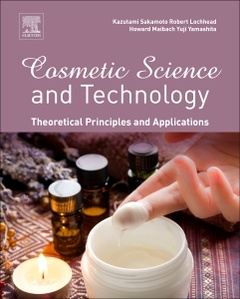Cosmetic Science and Technology: Theoretical Principles and Applications
Coordonnateurs : Sakamoto Kazutami, Lochhead Robert Y., Maibach Howard I., Yamashita Yuji

Cosmetic Science and Technology: Theoretical Principles and Applications covers the fundamental aspects of cosmetic science that are necessary to understand material development, formulation, and the dermatological effects that result from the use of these products. The book fulfills this role by offering a comprehensive view of cosmetic science and technology, including environmental and dermatological concerns.
As the cosmetics field quickly applies cutting-edge research to high value commercial products that have a large impact in our lives and on the world's economy, this book is an indispensable source of information that is ideal for experienced researchers and scientists, as well as non-scientists who want to learn more about this topic on an introductory level.
- Covers the science, preparation, function, and interaction of cosmetic products with skin
- Addresses safety and environmental concerns related to cosmetics and their use
- Provides a graphical summary with short introductory explanation for each topic
- Relates product type performance to its main components
- Describes manufacturing methods of oral care cosmetics and body cosmetics in a systematic manner
Part I. General View of Cosmetic Science and Technology 1. General Aspects of Cosmetics in Relation to Science and Society: Social, Cultural, Science, and Marketing Aspects 2. Global Cosmetic R&D Trends Unveiled From Past IFSCC Award-Winning Papers 3. Basic Physical Sciences for the Formulation of Cosmetic Products 4. Scouting to Meet Unmet Needs 5. New Aspects of Cosmetics and Cosmetic Science 6. Psychology of Cosmetic Behavior 7. Dermatological Benefits of Cosmetics 8. Development of Cosmetics and Intellectual Property Rights 9. Regulations on Cosmetics
Part II. Fundamental Resources for Cosmetics 10. Introduction to Cosmetic Materials 11. Nomenclature of Ingredients 12. Water 13. The Use of Polymers in Cosmetic Products 14. Powders and Inorganic Materials 15. Surfactants 16. Emollients 17. Bioactive Ingredients: Benefits of Cosmetics Stimulated Through Biological Aspects 18. Fragrance 19. Amino Acids, Peptides, and Proteins 20. Botanical Ingredients 21. Functional Materials for Hair 22. Nanotechnology in Cosmetics
Part III. Physicochemical Aspects and Formulations 23. Wetting and Surface Characterization 24. Molecular Structure and Phase Behavior of Surfactants 25. Lamellar Gel Network 26. Polymer-Surfactant Interactions 27. Rheology of Cosmetic Formulations 28. Emulsion and Emulsification Technology 29. Microemulsions and Nano-emulsions for Cosmetic Applications 30. Effect of Molecular Assembly for Emulsion and Gel Formulations 31. Liposomes for Cosmetics 32. Skin Care Cosmetics 33. Body Care Cosmetics 34. Makeup Cosmetics 35. Ultraviolet Care Cosmetics 36. Hair Care Cosmetics 37. Sensory Measurement-Evaluation and Testing of Cosmetic Products 38. Structural Analysis of Formulations 39. Increasing Productivity by Reducing Carbon Footprint in Cosmetics Processing
Part IV. Physiological and Dermatological Aspects 40. Structure and Function of Skin From a Cosmetic Aspect 41. Skin Lipids 42. Structural Aspects of Stratum Corneum 43. Skin Aging 44. Melanogenesis 45. Sensitive Skin 46. Skin Penetration 47. Effects of Air Pollution on Skin: Dermatologic Options 48. Hair Physiology (Hair Growth, Alopecia, Scalp Treatment, etc.) 49. Clinical Evaluation and Instrumental Techniques in Dermatology 50. Safety Evaluation 51. Safety Assessment of Cosmetic Ingredients
Chemical engineers, chemists, physical chemists and cosmetic chemists in cosmetics research and developments, dermatologists, toxicologists
Kazutami Sakamoto is a professor of Faculty of Pharmacy at Chiba Institute of Science since April, 2010. He is also an adjunct professor of Dept. of Pure & Applied Chemistry, Faculty of Science & Technology, at Tokyo University of Science. He has graduated the master program of Applied Chemistry, School of Engineering at Tohoku University in 1971 after finishing undergraduate program at the same university. He has received the diploma of Ph. D. from Faculty of Science at Tohoku University in 1980. In 1971 he has joined the Central Research Laboratories of Ajinomoto Co., Inc as a research chemist and spent most of his professional carrier with the company till 2003. During his time with Ajinomoto, Dr. Sakamoto has long been engaged in the development of the Ajinomoto's functional chemical products especially cosmetic ingredients. He also has conducted many basic researches in the area of colloid and interfacial chemistry and skin science. In 2003 he has retired from Ajinomoto and joined to Shiseido Research Center as a Resident Special Technical Advisor and spent three years to consult creation and promotion of Shiseido's new R&D projects. After then he has worked for Seiwa kasei Co. LTD. as a director of R&D. Along with industrial carrier, Dr. Sakamoto has been active in research and educations at Universities as Yokohama National University, Shinsyu University then Tokyo University of Science as an adjunct professor. After retiring from industry in 2008, he has been expanding academic activities.
Dr. Sakamoto has elucidated extensive research on the physicochemical properties of aminoacid based chiral molecules especially at their self assembled conditions since late 1970s. His explorations of chiral self assemblies including micelles, lyotropic liquid crystals are one of the pioneering studies in 1970s. Discovery of lyotropic cholesteric liquid crystal formed by acylamino acid as a chiral surfactant is a good example of them. Never ending his curiosity o
- Covers the science, preparation, function, and interaction of cosmetic products with skin
- Addresses safety and environmental concerns related to cosmetics and their use
- Provides a graphical summary with short introductory explanation for each topic
- Relates product type performance to its main components
- Describes manufacturing methods of oral care cosmetics and body cosmetics in a systematic manner
Date de parution : 03-2017
Ouvrage de 854 p.
21.5x27.6 cm
Disponible chez l'éditeur (délai d'approvisionnement : 14 jours).
Prix indicatif 242,37 €
Ajouter au panier